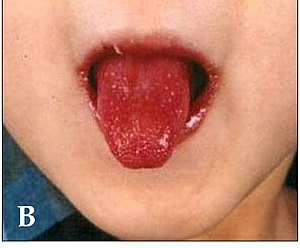Kawasaki disease
| Kawasaki disease | |
|---|---|
| Synonyms | Kawasaki syndrome, lymph node syndrome, mucocutaneous lymph node syndrome |
 |
|
| A child showing the characteristic "strawberry tongue" seen in Kawasaki disease | |
| Classification and external resources | |
| Specialty | Pediatrics |
| ICD-10 | M30.3 |
| ICD-9-CM | 446.1 |
| OMIM | 611775 |
| DiseasesDB | 7121 |
| MedlinePlus | 000989 |
| eMedicine | article/965367 |
| Patient UK | Kawasaki disease |
| MeSH | D009080 |
| Orphanet | 2331 |
Kawasaki disease is a disease in which blood vessels throughout the body become inflamed. The most common symptoms include a fever that lasts for more than five days and is not controlled by usual medications, large lymph nodes in the neck, a rash in the genital area, and red eyes, lips, palms or bottoms of the feet. Other symptoms include sore throat and diarrhea. Within three weeks of the onset of symptoms the skin from the hands and feet may peel. Recovery then typically occurs. In some children, coronary artery aneurysms may form in the heart.
The cause is unknown. It may be due to an infection triggering an autoimmune response in those who are genetically predisposed. It is not spread between people. Diagnosis is usually based on a person's signs and symptoms. Other tests such as an ultrasound of the heart and blood tests may support the diagnosis. Other conditions that may present similarly include scarlet fever and juvenile rheumatoid arthritis.
Initially treatment is typically with high doses of aspirin and immunoglobulin. Usually with treatment fever resolves within 24 hours and there is a full recovery. If the coronary arteries are involved ongoing treatment or surgery may occasionally be required. Without treatment coronary artery problems occur in up to 25% and about 1% die. With treatment the risk of death is 0.17%.
Kawasaki disease is rare. It affects between 8 and 67 per 100,000 people under the age of five except in Japan where it affects 124 per 100,000. It is much less common after the age of five. Boys are more commonly affected than girls. The disorder was first described in 1967 by Tomisaku Kawasaki in Japan.
...
Wikipedia
